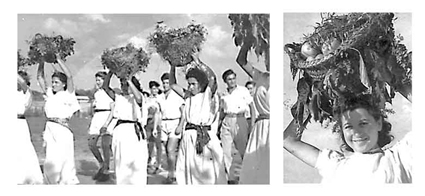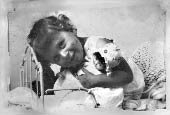We are driving along the only road that leads through the Judean Desert south towards Masada. All is bare but for a patch of green here, and another one there, denoting a kibbutz; where a lot of effort is put in to make this desert bloom; a vast rocky emptiness that is hard to comprehend.
How can I make you feel this vastness? This emptiness? Its deadness if I can call it that way, even though there is life everywhere.I thought of showing you all that we have filmed, but then it will go forever, and still, it will not be it, will it?The Hebrew calls it‘
It is hard to comprehend that people in biblical times lived in this environment by choice, in small settlement like in Qumran, or in caves one can see along the way, till you realize that living here was better than living under the noses of the so cruel Romans.
 <
<The Judean wilderness, a kibbutz in the distance
Deep in the Judean desert, 450 meter above and overlooking the now receding Dead Sea, stands the mighty fortress rock of Masada. Majestic in its beauty, and fascinating in its history, it is a place of pilgrimage to all Israelis and many others around the world.


Arial map in blue
Here, after 3 years of siege, about 960 people chose death in freedom over life in slavery – Roman slavery, and I quote out of Josephus:
From Elazar benYair final speech (the Zealots Commander)
At the end of the 3-year siege, when at long last the fortress walls were breached, the Roman got the surprise of their lives - they were greeted with silence.
There was nothing for the ‘Triumph Parade’.No slaves for sale.
Apart of two women and five children that hid themselves, there were only dead bodies…
With the fall of Masada, the last resistance to Roman rule came to an end. Jerusalem was in ruin already and the temple no longer stood. After one more revolt in 132-135, Rome had enough. To ensure the Jews will no longer rise against her, the population was dispersed throughout the Roman world and Judea’s name was change to ‘Palestina’ – a name they coined from the name of the Philistines – the Anatolian ‘sea people’ who lived along the southern Mediterranean shore of the country and were long gone by that time.
Nowadays, Israeli soldiers take here the oath: "Masada shall not fall again."
Masada was first fortified was by ‘Jonathan the High Priest’ who lived in103-76 BCE.
Between the years 37 and 31 BCE ‘Herod the Great’, the crazy king, who killed anyone at a whim including his wife and children, and one of the world’s greatest architect, built into this rock his fortified 3 level summer palace, overlooking the Dead Sea. A palace in the best of Roman style; fit not only for a king but for an emperor as well. Here as in any other place he built, Herod spared nothing: Palaces and villas, throne room and synagogue; water cisterns, bathes, frescoes and storerooms and more.

Harod’s palace overlooking the Dead Sea
After the fall of Jerusalem and the destruction of the magnificent Temple, crazy Herod built; a group of zealots took Masada over.
Around 73 CE, Rome collected her best legions from all over its empire, and from as far as Britain, to lay the 3-year siege of Masada. They brought with them thousands of Jewish prisoners-of-war slave labour, to build rampart of thousands of tons of stones and beaten earth against the western approaches of the fortress; and battering rams to breached its walls.

Part of the way up the rock of Masada

View from above onto the Roman camp area
As you stand at the top of Masada looking down, you can still see the Roman army’s camp area and that of the slave’s as well.

The Roman rampant
There is so much about Masada to study and so many lessons to learn.Books were written and still are, and theories developed. Archaeologist have turned over and looked into every nock and cranny of this place, and Josephus, the Jewish General who fought the Romans in the Galilee and later Romanised to become the emperor’s friend and historian, left in his book ‘The wars of the Jews’ the only account we have today from that time in the history of the holy land.
Renate
http://www.promisedland-renate.com
If you want to know more go to
Masada photos
http://fourquestions.us/albums/Israel2006/Masada/photos/photo2.html
Masada history
http://www.jewishvirtuallibrary.org/jsource/Archaeology/Masada1.html







2 comments:
Great post on Masada, and thanks for linking to my photo gallery!
Hi Joshua,
Thank you for visiting and commenting. Our trip to Masada was a high light in our visit to Israel. Hope you had a look at some other of my post about Israel. Also, do go onto my website. You may find it interesting. Click on the link about the photo of my book on the right column.
Renate
Post a Comment